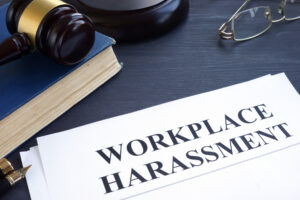Navigating the complexities of workplace dynamics can be challenging, especially when those dynamics cross the line into harassment. It’s an issue that, unfortunately, many individuals face, yet it remains shrouded in confusion and fear.
This blog aims to demystify harassment in the workplace, offering clear strategies for protecting yourself and fostering a culture of respect and dignity for all. If you have been the victim of discrimination, contact PLBH at (800) 435-7542 to speak to an employment law attorney.
Understanding Harassment
Harassment is not just about the overt acts we often hear about in the news. It’s a spectrum that ranges from subtle, demeaning remarks to explicit threats or physical actions. It can stem from biases against gender, race, religion, age, sexual orientation, or any other characteristic protected by law. Recognizing harassment is the first step in addressing it. It’s about the impact on the recipient, not the intent of the perpetrator.
Strategies for Self-Protection
1. Know Your Rights: Educate yourself on what constitutes harassment and the laws protecting you. Awareness is your first line of defense.
2. Document Everything: Keep a detailed record of any incidents, including dates, times, witnesses, and your response. This documentation can be crucial in any legal or HR inquiry.
3. Speak Up Early: Address the behavior directly if you feel safe doing so. Often, individuals may not realize their actions are unwelcome or harmful. A straightforward conversation can sometimes resolve the issue.
4. Report It: If the harassment continues or if you feel uncomfortable addressing it directly, report the behavior to a supervisor or HR. Companies have a legal obligation to investigate and address harassment complaints.
5. Seek Support: Whether it’s from coworkers, a trusted mentor, HR, or a professional counselor, support is critical. You’re not alone, and speaking out can not only help you but also prevent others from being victimized.
Creating a Supportive Work Environment
Employers and employees alike play vital roles in establishing a workplace free from harassment. Employers should:
- Implement and enforce a zero-tolerance policy on harassment.
- Provide regular training on recognizing and preventing harassment.
- Create a safe and confidential process for reporting incidents.
- Take immediate and appropriate action against offenders.
Employees can contribute by:
- Respecting diverse perspectives and backgrounds.
- Intervening or offering support when witnessing harassment.
- Encouraging an inclusive and supportive workplace culture.
The Role of Legal Counsel
Understanding when and how to seek legal advice is crucial. If you’ve reported harassment and it continues, or if your employer retaliates against you for reporting, it may be time to consult with an attorney. Legal professionals specializing in employment law can offer advice, help you understand your rights, and, if necessary, guide you through the process of legal action.
Moving Forward
Facing workplace harassment is undoubtedly challenging, but no one should tolerate it as a “normal” part of their job. By understanding your rights, taking proactive steps to protect yourself, and advocating for a respectful work environment, you can help draw the line against harassment. If you’re experiencing harassment, remember, taking action not only asserts your rights but also paves the way for a safer workplace for everyone.
For those seeking more detailed guidance or who find themselves in a situation that requires legal intervention, reaching out for professional advice is a critical next step. Remember, you have the right to work in an environment where your dignity, rights, and well-being are respected and protected. Contact PLBH at (800) 435-7542 for a legal consultation with an attorney.

